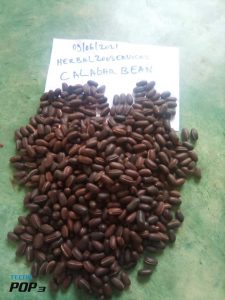Calabar bean Medicinal uses and health benefits you should know..
Do you know that the popular anaesthetic drug, PHYSOSTIGMINE was first discovered in Nigeria? Its chemical name is eserine (esere in Calabar language). PHYSOSTIGMINE comes from the popular toxic Calabar beans.
That said: What are the medicinal uses and health benefits of Calabar bean.
The truth is, Calabar bean , without the active agent being isolated and refined , is very poisonous and should never be eaten or swallowed.
Calabar bean medicinal uses
Here are some evidience-based medicinal uses of calabar beans. When talking about the medicinal usefulness of Calabar bean, it does not mean the seed, we mean extract from the seed. The Calabar bean sees on its own is very poisonous and lethal.
1. Physostigmine extracted from the Calabar beans is used to produce contraction of the pupil of the eye. This could be beneficial in persons with glaucoma and for eye tests in ophthalmology clinics.

2. It has been employed in the treatment of tetanus and as an antidote for strychnine poisoning.
3. Large dose of the alkaloid from Calabar bean causes death by increasing blood pressure and suffocation. This is useful in countries who still practice death sentence by injection of toxins.
4. Calabar beens have found used in the treatment of epilepsy and convulsions.
5. Extract from Calabar beans is used in the treatment of cholera
6. Calabar seed relieves constipation
7. Calabar bean is a potent muscle relaxant used to treat painful muscle spasms.
Precautions
The following group of persons should avoid taking Calabar bean as it can worsen their condition:
1. Parkinson’s disease patients.
2. Patients with heart diseases or low heart beat
3. Asthmatic patients
4. Patients with kidney diseases
5. Sickle cell patients.
6. Avoid Calabar bean in pregnancy
7. Diabetics should not take Calabar bean
How eserine was discovered from Calabar bean
Eserine is a compound which paralyses the muscles when used and kept in the mouth without swallowing.
In Calabar, during the olden days, it was used to determine innocence or guilt over an allegation and for witchcraft hunting.
Suspects were told to swallow the seed (Calabar bean).
Innocent people swallowed it without any issues as the stomach acid digested the seed.
Guilty people, afraid to swallow, kept it in their mouths and sometimes inadvertently chew it, paralysing their muscles and thus “establishing” guilt.
Of course, there would be some daring guilty ones who swallowed and went Scot Calabar bean is more toxic if chewed so those who swallowed it wholly without chewing may be unharmed.
The Europeans, unfazed by the “Juju” behind the seed, worked on, and isolated the active compound called eserine ( from the calabar language term esere).
Today, it is used world wide as an anaesthetic for general surgery, while the citizens of the country where it came from, are asking people to “visit their village” and see how Juju works.
This article is the intellectual property of www.nimedhealth.com.ng























